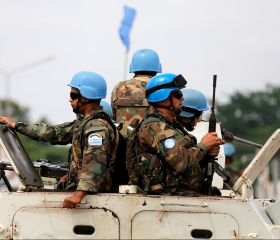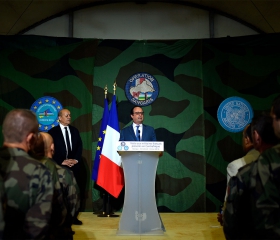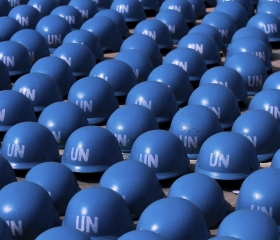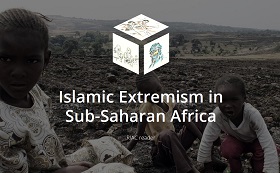In the past 25 years, Africa has made great strides towards development and peace, but conflict is still present in many places on the continent. For this reason, there has been an unprecedented surge in both the scale of peacekeeping and peacebuilding activities, as well as in the number of actors engaged in conflict resolution. Complex and challenging, the African security landscape presents the United Nations (UN), the African Union (AU), and the broader international community with numerous opportunities for trial, error, and experimentation.
The African continent has long been subject to much mythmaking and stereotyping, with countless colonial and postcolonial legacies haunting it to this day. Relatively far from contemporary great power interests, with the exception of Great Britain and France (historically) and China (recently) and thus under the radar for most policy-makers, Africa often comes across as a space that is uniformly underdeveloped and backward, awash with ethnic violence and terrorism, overwhelmed by disease, kept on a leash by Bretton Woods institutions, and exploited by predatory local elites and dictators. The reality, of course, is much more complex. Africa is a place of great economic and cultural diversity, and as such, it is anything but uniform. It is true that many security and socio-economic issues remain. Ethnic conflicts are indeed present on the continent, and in some areas, diseases like HIV and malaria are a critical health security issue. Africa certainly remains a ‘penetrated’ continent vulnerable to foreign intervention, and in many countries state institutions require strengthening and reinforcement. In this regard, in the past 25 years there has been an unprecedented surge in peacekeeping (PK) activity in Africa.
Peacekeeping in High Demand
A boom in peacekeeping in Africa accompanied a rise in the number of actors involved in conflict management on the continent. While the United Nations (UN) remains the dominant actor in the field, in recent years other actors, namely the African Union (AU), the European Union (EU), and France, have also expressed interest — and at times, demonstrated capacity — in participating in peace operations there.
First, however, it is helpful to define our terms. The UN Capstone Doctrine defines peacekeeping as “a technique designed to preserve the peace, however fragile, where fighting has been halted, and to assist in implementing agreements achieved by peacemakers”. It also notes that over the years, peacekeeping has evolved from monitoring ceasefires and terms of peace agreements (‘traditional peacekeeping’) to include such complex peacebuilding and post-conflict reconstruction activities as rebuilding military, police, and justice institutions (“Security Sector Reform”), disarming and reintegrating former combatants, promoting human rights, overseeing elections, and protecting civilians in conflict. This expanded model, which includes traditional PK tasks but goes above and beyond them, has come to be known as ‘multidimensional’, with ‘peace operations’ becoming a more general term covering both types of missions.
These peace operations can be carried out by a variety of actors. As suggested by Alex J. Bellamy and Paul D. Williams, peace operations can be divided into UN-led (authorized, mandated, and operationally managed by the Organization), UN-authorized (authorized, mandated, but not managed by the UN), UN-recognized (authorized, but not mandated or managed), and non-UN (neither authorized, nor mandated, nor managed) ones. According to this classification, in Africa there are currently 9 UN-led, 2 UN-authorized, and 4 UN-recognized missions. The UN operates the UN Mission for the Referendum in Western Sahara (MINURSO, 1991), the Mission in Liberia (UNMIL, 2003), in Ivory Coast (UNOCI, 2004), and much more recently the UN Stabilization Mission in the Democratic Republic of the Congo (MONUSCO, 2010), the Mission in South Sudan (UNMISS, 2011), the Interim Security Force for Abyei in the contested Abyei region between Sudan and South Sudan (UNISFA, 2011), the Multidimensional Integrated Stabilization Mission in Mali (MINUSMA, 2013), and the Multidimensional Integrated Stabilization Mission in the Central African Republic (MINUSCA, 2014). Additionally, the UN leads a hybrid mission with the African Union in the Darfur region of Sudan (UNAMID, 2007). Outside of the UN, there are three predominant peacekeeping players: the African Union, the European Union (EU), and France. The AU manages a single mission in Somalia (AMISOM, 2007), while the EU operates 4 military training missions in Mali (2013), in CAR (2016), as well as two military ones in Somalia (2008, 2010). France has recently ended three of its military operations (in Chad, Mali, and CAR), and has instead chosen to focus on its Sahel-wide Operation Barkhane (2014).
Who’s in Charge?
There exists a multiplicity of peacekeeping actors in Africa espousing different approaches, each with their own strengths and weaknesses. UN missions tend to address the most diverse array of tasks and range from MINURSO, overseeing a ceasefire in the desert, UNOCI and UNMIL, which are peacebuilding missions, to robust and complex missions deployed in the midst of ongoing low and mid-intensity conflicts, such as in the DRC, the Sudans, Central African Republic, and Mali. Able to marshal a large amount of resources, coordinate between the various agencies that make up the UN system, as well as holding enormous institutional experience in peacekeeping and peacebuilding, the UN would appear to be the peacekeeper par excellence. Nevertheless, there are situations where the UN finds itself at a disadvantage.
At the outset of conflict or immediately after the conclusion of a peace agreement, a country is usually in a very unstable state. To avoid relapse into all-out war, a peace operation needs to be deployed quickly and be ready to bear casualties in the face of rampant violence. The UN — often cumbersome, bureaucratic, slow to react to crises, and averse to personnel losses — may not then be the best option. The AU, on the other hand, flawed in ways discussed below, has the capacity to deploy quickly and forcefully, and establish a tenuous peace to later be consolidated by the UN over the medium and long term (5-10 years). The AU is less tied down by red tape and generally has greater discretion in its actions. As such, the UN-AU symbiosis is a relatively regular occurrence: for instance, the UN successfully took over after the AU in Liberia, Mali, and CAR. The AU is thus often compared to a firefighter who puts out the fire and leaves the restoration work to others. A good example of this is the AU mission in Somalia, which is primarily aimed at combating terrorist groups like Al-Shabaab in support of the internationally-recognized government in Mogadishu.
This stands in sharp contrast to French and EU missions. While the latter — run by the Common Security and Defence Policy (CSDP) — specialize in long-term training missions aimed at capacity-building of African police or armed forces, France tends to selectively intervene in the short-term and is able to carry out tasks for which other organizations are simply unfit, or not mandated for, such as counter-terrorism. Namely, of the three, it is France that finds itself in the best logistical situation. Even though France generally enjoys less legitimacy than either the UN, the AU, or the EU, with bases in Djibouti, Chad, the Ivory Coast, Gabon, Senegal, Niger, Mali, and Burkina Faso, it is exceptionally well-positioned to carry out counter-terrorism missions across large interconnected areas of the Sahel region. That said, the financial toll of such operations remains heavy, and in 2016 what the French call “external operations” cost between 1,1 and 1,2 billion euros. Taken together, these actors create a particular division of labour between the “short-term firefighters” and the “long-time capacity-builders”.
African Solutions to African Problems
Although every peacekeeping actor in Africa has a comparative advantage, most observers agree that long-term peace on the continent depends on the Africans’ ability to manage and resolve regional conflicts by themselves in the spirit of “African solutions to African problems”. The centrepiece of this philosophy adopted by the African Union is the African Peace and Security Architecture (APSA) — a system of institutions modelled after the UN and designed to serve as a platform for security cooperation between African states and the African Regional Economic Communities (the RECs). The creation of APSA in 2002 meant that the African Union would have its own ready-for-deployment peacekeeping force through the African Standby Force (ASF). But as of 2017, the ASF is yet to become fully operational.
Because the AU’s peacekeeping capacity is still nascent, the brunt of peacekeeping activities on the continent continues to fall on the UN, which often finds itself in uncharted waters. The UN has to deal with new formats of peace operations, such as the first hybrid UN-AU mission in Darfur, as well as with a slew of unprecedented strategic challenges and difficulties reflected by the travails of MONUSCO in the DRC, MINUSMA in Mali, and by UNMISS in South Sudan.
In the DRC, MONUSCO is primarily engaged in the eastern Kivu and Ituri provinces, where an insurgency fuelled by a combination of local and regional factors has kept the conflict on-going for many years. Unable to manage and monitor the vast swathes of eastern DRC and properly fulfil its mandate to protect civilians, the mission has seen a large increase in personnel numbers, as well as the establishment of a new component — the DRC Intervention Brigade, charged with peace enforcement and strategic use of force. Although the Brigade was established explicitly without “creating a precedent or prejudice to the agreed principles of peacekeeping”, it nevertheless was an important development outside of the ‘holy trinity’ of UNPK principles of including impartiality, consent of the parties, and the non-use of force except in self-defence. In Mali, the UN operation is sitting on top of a peace agreement that has been extremely difficult to implement, is constantly challenged by irregular armed groups, and targeted for terrorist attacks while the mission itself is unable to mount an effective response. In South Sudan, the UN is dealing with a staggering task of protecting almost 200,000 civilians at Protection of Civilians (PoC) sites with the end to the civil war nowhere in sight.
Apart from operational challenges and constraints, an additional obstacle towards more effective peacekeeping in Africa has been the funding of the operations, fraught by shortages, discrepancies, and imbalances. While the UN has to contend with an $8bn peacekeeping budget (less than 1.4% of the US defence budget), the AU’s budget is much lower. The African Standby Force depends almost completely on outside funding, and in the case of AMISOM in Somalia, despite contributions from the troop-contributing countries (TCCs), it is the EU that pays all troop salaries. Such overdependence on one major source creates a problem where, if the EU decides to cut funding, like it did in 2016, it causes interruptions for the TCCs and paralyzes the mission, allowing spoilers, such as Al-Shabaab, to regain ground in parts of Somalia.
***
Although in recent years regional states and the African Union have made significant progress towards creating an effective institutional infrastructure for peaceful conflict resolution in Africa, it remains a long-term project. Apart from exceptional cases, such as Somalia, peacekeeping largely falls on the United Nations and outside state actors like France, and for the foreseeable future any fundamental changes are unlikely. Given the gravity and the scale of security challenges on the continent, Africa will remain the biggest and the most important laboratory for international peacekeeping.








